3 ways to change IP address in Windows 10
Have you ever wondered how to change IP address in Windows 10? Want to learn how to do that from the Settings app or Windows 10 Control Panel? Maybe you're a fan of the command line and want to learn how to change IP address in Windows 10 using CMD (Command Prompt) or PowerShell? Read on and find out how all of this is done in Windows 10.
NOTE : To be able to change the IP address in Windows 10, you must log in to Windows 10 with an admin account. In addition, before learning how to change the IP address, it is best to know what the IP address and subnet mask are, how to find your computer's IP and the router's IP address.
Why change IP address?
Most people will rarely need to change their IP address. It's a normal part of computer setup, and websites require looking at IP addresses dozens (if not hundreds) of times a day.
Even so, there may be reasons to occasionally need to change your public or local IP address. The most common reasons include:
Protect security and privacy
Although abuse is rare, a public IP address allows others to find your general location. So, if you have a reason to stay anonymous, changing your IP address can make your computer look like a different one.
Regularly changing your external or public IP address can help you improve your overall security and privacy when browsing the web.
Change physical location
Your public IP address reveals your general geographic location, and changing your IP address can allow you to access geo-locked content, such as content from international streaming services. .
Avoid bans and blocks
If it knows your IP address, an entity could block you from accessing a particular website (this is sometimes called an "IP ban") or disable your access to the Internet using an attack. Denial of Service (DoS). Changing the IP is a good way to avoid this.
If you want to access a country's catalog of online media services when you are outside that country for any reason, changing your IP to an IP located in the appropriate country may help. you get the category you are looking for.
Likewise, if you are a gamer looking to reduce your latency, changing your IP through a gaming proxy server can help improve performance. A great tech trick for second language learners is to use an IP address in another country to generate search results and local publications written in the native language.
Troubleshoot
You may want to change your local IP address for technical troubleshooting purposes. For example, in rare cases, you may need to change your local IP address to avoid conflicts with other devices on your network.
If you just installed a new home router, you may need to reconfigure your network by changing your IP on the fly. A common problem among home routers is that they sometimes give devices the wrong IP address, so changing the IP manually can resolve such glitches.
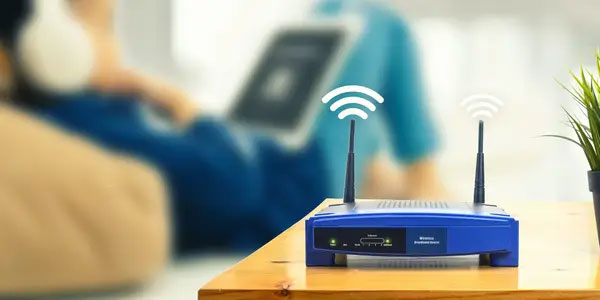
Is changing IP address illegal?
No, changing your IP address is not illegal. People change their IP addresses frequently when faced with direct attacks on online security, when testing a website before it goes live, or when they just want to protect their privacy. .
But if you've changed your IP to impersonate an individual or a business - commonly known as IP spoofing - you're breaking the law. You can also get into trouble if you change your IP address to access a website that you are banned from. IP spoofing is also a tool used by some cybercriminals to carry out a number of high-profile attacks, most commonly those involving identity theft and denial of service attacks. The purpose is to cripple the website.
1. How to change IP address in Windows 10 using the Settings application
Because it relies on the operating system's intuitive interface, this is probably the easiest method to change the IP address of a Windows 10 computer or device. Here's what you need to do:
Step 1: Open the Settings application.
Step 2: In the Settings app , open the Network & Internet category .
Step 3: On the left sidebar, select your network type. If you connect to the Internet (or local network) using a wireless card, select WiFi. If you are accessing the Internet (or LAN) using a wired connection, click Ethernet.
Step 4: On the right side of the window, click the network connection name.
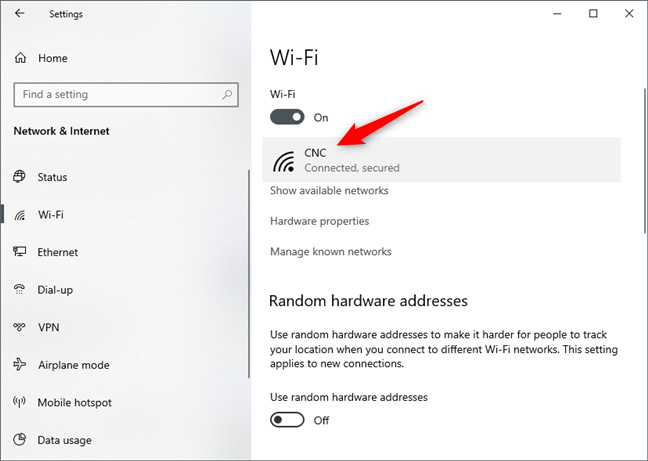
Step 5: Scroll down on the network connection details page until you find the section called IP settings. Then, click Edit , under IP assignment.
Step 6: The Settings application now displays the Edit IP settings dialog box . This is where you can change the IP address of your computer or device. If you want the router to assign the IP address of your Windows 10 PC automatically, select Automatic (DHCP) . This is also known as dynamic IP address.

Step 7: If you want to set your own static IP address, select Manual and then turn on the IPv4 and/or IPv6 toggle switch , depending on the Internet protocol you want to use.
Note that each of these options has a separate IP address, so you must enter the required details for both IPv4 and IPv6 if you choose to enable both.
Step 8: To change the IP address to a static address, regardless of whether you set it for IPv4 or IPv6 protocol, you must enter the following details:
- IP address : Enter the static IP address you want to use. For example, you want to change the IP address (IPv4) of your Windows 10 PC to 192.168.50.10.
- Subnet prefix length : Enter the prefix length that determines the size of the subnet. For example, the article has configured the router to use a subnet mask of 255.255.255.0 , which means entering "Subnet prefix length" is 24. If the subnet mask is 255.255.0.0, the prefix length will be 16, etc.
- Gateway: Enter the router's IP address. In the case of the example, it is 192.168.50.1.
- Preferred DNS and Alternate DNS settings are not required. If you leave them blank, they will be automatically assigned by the router. However, if you also want to change them, you can do so.
Once you have entered all the details, click Save to have the IP address changed by Windows 10.
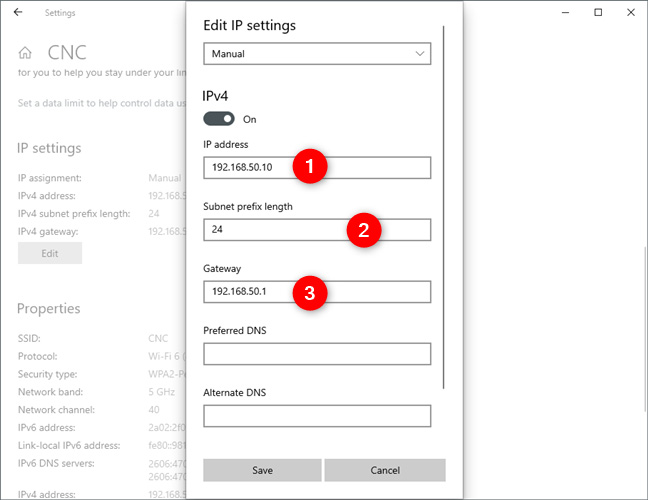
NOTE : If you choose to use a static IP address, make sure that all the details you enter are correct; otherwise, your Windows 10 PC will lose its Internet connection. If that happens, change your IP address back to Automatic (DHCP) so the router can change it to a working address.
2. How to change IP address in Windows 10 using Control Panel
In Windows 10, you can also change your IP address from Control Panel.
Step 1: Open Control Panel and click View network status and tasks under Network and Internet .
Step 2: In Network and Sharing Center , click on your Internet connection from the "View your active networks" area .
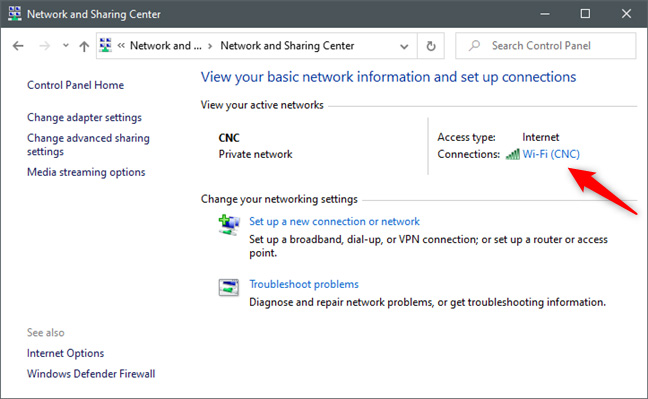
Step 3: In the Network Connection Status window , click Properties.
Step 4: In the Properties window , select Internet Protocol Version 4 (TCP/IPv4) or Internet Protocol Version 6 (TCP/IPv6) , depending on the IP address you want to change. If you want to change both, repeat the next steps for each option.
Step 5: Click Properties.

Step 6: The previous operation will open a window called Internet Protocol Version 4 (TCP/IPv4) Properties or Internet Protocol Version 6 (TCP/IPv6) Properties , depending on what you selected previously. Here's where you can change your IP address:
- If you want to use the dynamic IP address automatically assigned by the router to your Windows 10 PC, select Obtain an IP address automatically . Then, click OK and close all the windows you have open.
- If you want to set a static IP address for your network adapter, select Use the following IP address . Then, enter the required details manually: IP address, Subnet mask and Default gateway , just like in the previous section.
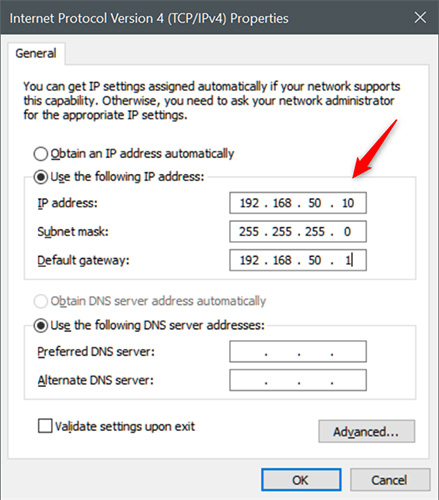
Step 7: Save the new IP address settings by clicking OK , then close all windows you opened during the process.
3. How to change IP address in Windows 10 using PowerShell or Command Prompt (cmd)
To change the IP address on your computer is not difficult, you can use Control Panel or Settings as mentioned above. However, you may not know that using Command Prompt can also change the IP address. In particular, using Command Prompt to change the IP address will be much faster than using Control Panel.
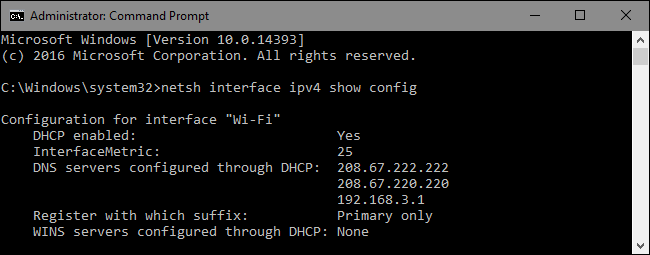
The netsh command allows you to configure some network connection settings on Windows operating systems. However, this process requires Command Prompt under Admin.
To open Command Prompt under Admin:
On Windows 10 or Windows 8.1, right-click the Start button on the Taskbar or press the Windows + X key combination to open the Power User Menu, where you click Command Prompt (Admin).
On previous versions, you enter command prompt into the Search box on the Start Menu, then on the search results list, right-click Command Prompt and select Run as Administrator.
View network connection information
Before changing the IP address and related information, you need to find the full name of the network connection you want to change. To do this, use the command:
netsh interface ipv4 show config
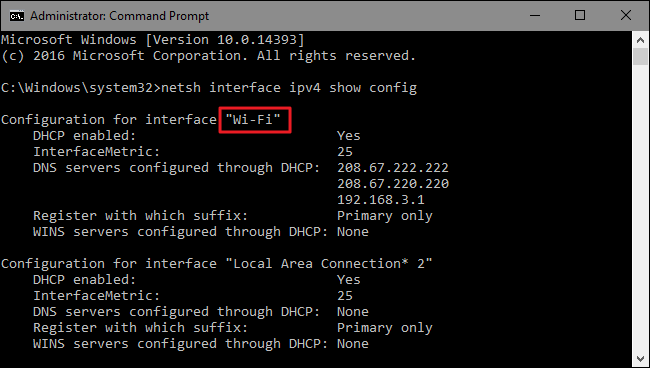
Scroll down until you find the interface you want to find. In the example above, the Network Administrator edits the Wifi interface, so we proceed to find Wifi. You can also see other default names that Windows assigns to the interface, such as Local Area Connection, Local Area Connections* 2 and Ethernet.
Just find the exact network connection name and copy and paste it into Notepad to use in the next steps.
Change IP address, Subnet Mask and Default Gateway
To change the IP address, Subnet Mask and Default Gateway , use the command:
netsh interface ipv4 set address name="YOUR INTERFACE NAME" static IP_ADDRESS SUBNET_MASK GATEWAY
Suppose you enter the command as:
netsh interface ipv4 set address name="Wi-Fi" static 192.168.3.8 255.255.255.0 192.168.3.1
In the command in the example above, replace the following information:
- Interface name is Wifi
- Set IP address to 192.168.3.1
- Set Subnet mask to 255.255.255.0
- Set Default Gateway to 192.168.3.1
And if you use a static IP address but you want to switch to using an IP address automatically assigned by a DHCP server, such as a router, you can use the command below:
netsh interface ip4 set address name='YOUR INTERFACE NAME' source=dhcp
Change DNS Settings
Additionally, you can use the netsh command to change DNS servers. Third-party DNS Server applications such as Google Public DNS and OpenDNS can support faster and more reliable DNS servers provided by ISPs.
Whatever your purpose of changing DNS server is, you can do it on the router. If you want to change a computer's DNS server, you can easily do it with the netsh command.
You will have to use 2 commands: one command is to set up the primary DNS server and one command is to set up the secondary DNS server or backup DNS server .
To set up primary DNS server , use the command:
netsh interface ipv4 set dns name="YOUR INTERFACE NAME" static DNS_SERVER
Suppose if you set up Google's primary public DNS server, 8.8.8.8, you use the command:
netsh interface ipv4 set dns name="Wi-Fi" static 8.8.8.8
To set up Secondary DNS Server , use the command:
netsh interface ipv4 set dns name="YOUR INTERFACE NAME" static DNS_SERVER index=2
Suppose if you want to set the secondary DNS of Google Public DNS secondary server to 8.8.4.4, use the command:
netsh interface ipv4 set dns name="Wi-Fi" static 8.8.4.4 index=2
With the IP address, you can change it to set up automatic DNS. Use command:
netsh interface ipv4 set dnsservers name"YOUR INTERFACE NAME" source=dhcp
Refer to some more articles below:
Good luck!
You should read it
- 3 ways to change the Mac address on Windows 7/8 / 10
- How to change the Mac address on Windows 10, 8, 7
- How to change MAC addresses on Windows, Linux and MAC OS X
- How to change the IP address in Windows 10
- Top 5 software to change MAC address on Windows 10
- How to Change IP Address on Mac
- How to change the MAC address on Windows, Linux and Mac OS
- How to Change the IP Address on a Mac
May be interested
- How to Change the IP Address on a Mac
 changing your ip address can be useful if you want to avoid being attacked by other users who are targeting your ip address, or if you simply want a new online identity from an ip standpoint. you can change your ip address on a mac at any...
changing your ip address can be useful if you want to avoid being attacked by other users who are targeting your ip address, or if you simply want a new online identity from an ip standpoint. you can change your ip address on a mac at any... - How to Change Your IP Address (Windows)
 this wikihow teaches you how to change both your public ip address and your private ip address on a windows computer. your public ip address is the address that your computer broadcasts to other networks, while your private ip address is...
this wikihow teaches you how to change both your public ip address and your private ip address on a windows computer. your public ip address is the address that your computer broadcasts to other networks, while your private ip address is... - How to Change IP Address on Windows
 this is an article on how to change public and private ip addresses on windows computers. a public ip address is the address from which your computer transmits signals to other networks.
this is an article on how to change public and private ip addresses on windows computers. a public ip address is the address from which your computer transmits signals to other networks. - 2 simple ways to view and read MAC addresses on Windows 10 computers
 the mac address is the unique identifier or identifier of each device assigned by the manufacturer on each device. the mac address is 48 bits long.
the mac address is the unique identifier or identifier of each device assigned by the manufacturer on each device. the mac address is 48 bits long. - How to change MAC address on Windows, Linux and macOS X
 one of the errors of not being able to catch wifi waves is because the mac address of the computer network card does not match the mac address of the main wifi network. therefore, you need to change the mac address on your computer.
one of the errors of not being able to catch wifi waves is because the mac address of the computer network card does not match the mac address of the main wifi network. therefore, you need to change the mac address on your computer. - What is a static IP address?
 a static ip address is an ip address that is manually configured for the device, other than the address assigned through the dhcp server. it is called a 'static' address because it does not change.
a static ip address is an ip address that is manually configured for the device, other than the address assigned through the dhcp server. it is called a 'static' address because it does not change. - How to Change a Computer's Mac Address in Windows
 there might be a time when you want to change the mac address of your network adapter. the mac address (media access control address) is a unique identifier which is used to identify your computer in a network. changing it can help you...
there might be a time when you want to change the mac address of your network adapter. the mac address (media access control address) is a unique identifier which is used to identify your computer in a network. changing it can help you... - How to Refresh IP Address
 today's tipsmake will show you how to change the public ip address on your computer by performing power-cycling with your router. if you want to change your private ip address (the address assigned to your computer when connected to a local network), you need to execute the command prompt command on windows or access the network settings on your mac computer.
today's tipsmake will show you how to change the public ip address on your computer by performing power-cycling with your router. if you want to change your private ip address (the address assigned to your computer when connected to a local network), you need to execute the command prompt command on windows or access the network settings on your mac computer. - Change MAC address with Technitium MAC Address Changer
 in fact, there is a way to fake that mac address, basically making the adapter's address look like another address.
in fact, there is a way to fake that mac address, basically making the adapter's address look like another address. - How to set a static IP address for a Windows 11 computer
 step-by-step instructions to set up a static ip address on windows 11. 2 ways to change the static ip address on a windows 11 computer
step-by-step instructions to set up a static ip address on windows 11. 2 ways to change the static ip address on a windows 11 computer










 5 disadvantages of Xbox Game Pass to keep in mind
5 disadvantages of Xbox Game Pass to keep in mind Why does TV sound so bad? How to prepare?
Why does TV sound so bad? How to prepare? Reasons not to use password manager browser extensions, even though they are very convenient
Reasons not to use password manager browser extensions, even though they are very convenient A young man used 770 pieces of moldy potatoes to play Doom 1993 on a handheld computer
A young man used 770 pieces of moldy potatoes to play Doom 1993 on a handheld computer Apple AI privacy issues
Apple AI privacy issues Apple 'greenlight' the Epic Games Marketplace application in Europe
Apple 'greenlight' the Epic Games Marketplace application in Europe